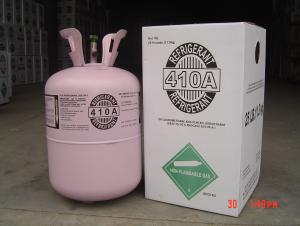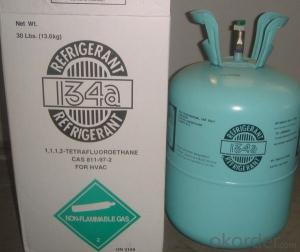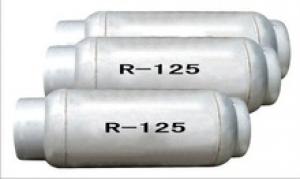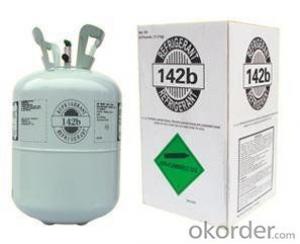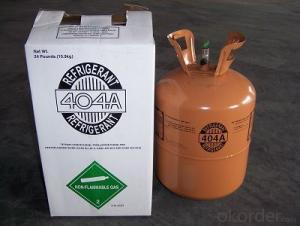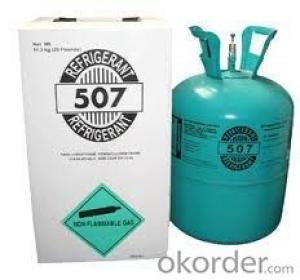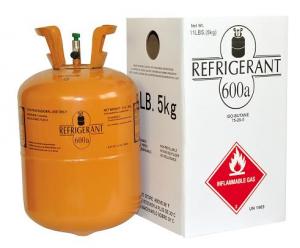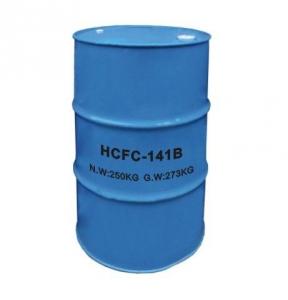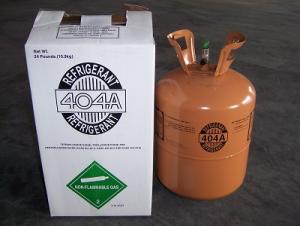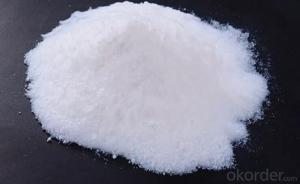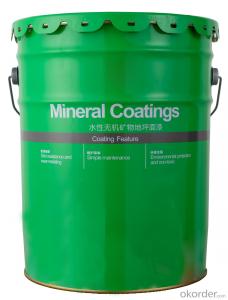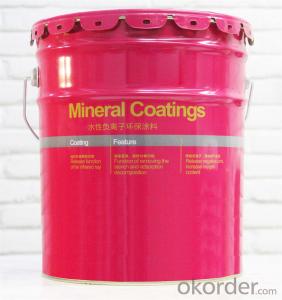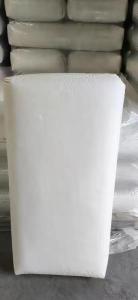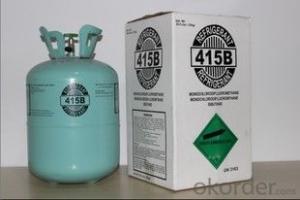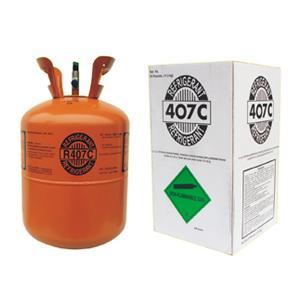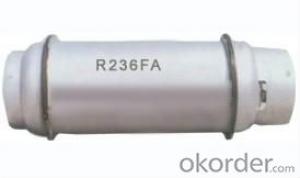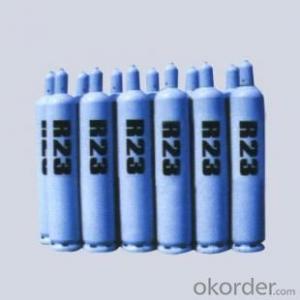Refrigerant Gas R502
- Loading Port:
- Shanghai
- Payment Terms:
- TT OR LC
- Min Order Qty:
- -
- Supply Capability:
- 1000MT m.t./month
OKorder Service Pledge
OKorder Financial Service
You Might Also Like
Specifications
1.Easy to evaporate
2.OEM is welcomed
3.Delivery within15 days
4.Disposable cylinder 30lb/13.6kg, 50lbs/22.7kg
Refrigerant R502 is a low temperature refrigerant which has a height refrigerating ability. It is mainly used as refrigerant for cooling showcase, refrigerant machines, low temperature refrigerators, low temperature compressors. It has higher refrigerating capacity and fast refrigerating rate.
Property of chloride
Formula: Azeotrope of F-22 and F-115
Ratio (w/w): F-22(48.8%), F-115(51.2%)
Molecular Weight: 111.6
B.P., °C: -45.4
Critical Temperature, °C: 82.2
Critical Pressure MPa: 4.075
Critical Density, g/cm3: 1.192
ODP(CFC-11=1): 0.221
QWP(CO2=1): 4500
Quality Standard
Appearance: Colorless, Transparent
Odor: Odorless
Moisture, ≤ %: 0.002
Acidity, ≤ %: 0.0001
Residue on evaporation, ≤ %: 0.01
- Q:What are the characteristics of organic compounds?
- Organic compounds are usually referred to as carbon-containing compounds, or hydrocarbon-containing compounds and their derivatives are collectively referred to as organic matter. Organic compounds are generally insoluble in water and soluble in organic solvents with lower melting points. The vast majority of organic matter heat easily decomposed, easy to burn. The reaction of organic matter is generally slow and often accompanied by side effects, and there are many kinds of organic compounds, which can be divided into two major categories of hydrocarbon and hydrocarbon derivatives. According to the organic groups contained in the functional groups, divided into alkanes, alkenes, alkynes, aromatic hydrocarbons and alcohols, aldehydes, carboxylic acids, esters and so on. According to the organic carbon molecular structure, can also be divided into open chain compounds, carbocyclic compounds and heterocyclic compounds three categories.
- Q:What is the difference between hot and cold asphalt?
- Grandmother next door aunt is the street to sell stewed meat, a child often see her burning a pot of hot asphalt pork hair, black asphalt boiled immediately leaching in the meat, and so dry quickly pull it down, pork will Change very clean and white, clean the meat will be directly thrown into the pot halogen system, this method relative to the traditional plucking save time and effort a lot. Here, please bloggers blame me to come to funny, because the end of the story is not funny, that aunt's little sister in the sixth grade when suffering from leukemia away, adults say with her home burning asphalt There are relationships, eighteen years later, and she only a few side of the edge of the I actually remember the full name of her sister, her looks, the tone of her voice, we played the game and we were a very curious In the asphalt pot to see the scene of pig hair ... ... hope that each parents do not ignore the child's growth in the small problem.
- Q:What is the current status of carbon dioxide capture technology and how is it compared to plants that absorb carbon dioxide?
- Landlord can check their own literature what. = For example, I think this review is very good. The Although it does not include relatively new progress, but I think it is quite good. The You see such an answer to the efficiency of how low ah not as good as their own to find the literature to see right
- Q:Is steel not organic synthetic material?
- Organic compounds that are organic compounds. Carbon compounds (carbon monoxide, carbon dioxide, carbonic acid, carbonates, metal carbides, cyanide excluded) or hydrocarbons and their derivatives in general. Most of the combustion can produce carbon dioxide and water.
- Q:How to do it? Solve Inorganic Chemistry
- Inorganic chemistry is one of the earliest disciplines in the development of chemical science. It undertakes a major task of studying the composition, structure, properties and reactions of all elements and elements (except hydrocarbons and derivatives). The current development of inorganic chemistry has two distinct trends, that is, in the breadth of the broadening and depth of the advance. It is the three pillars of modern civilization
- Q:NH4HCO3 and so have C atoms ah, why still inorganic
- Organic matter is a general term for carbon compounds (except carbon oxides, carbon dioxide, carbonates, carbonates, bicarbonates, metal carbides, cyanides, thiocyanides and other oxides) or hydrocarbons and their derivatives. Organic matter is the material basis for life. The inorganic compound usually refers to a compound containing no carbon element, but a few carbon-containing compounds such as carbon dioxide, carbonic acid, carbon monoxide, carbonate and the like do not have the properties of an organic substance, and therefore such substances are also inorganic.
- Q:Is polyethylene a derivative of hydrocarbons?
- The definition is yes
- Q:Inorganic chemistry employment direction? Current research direction
- Inorganic chemistry is the science of the composition, nature, structure and reaction of inorganic matter, which is the oldest branch of chemistry. Inorganic substances include all chemical elements and their compounds, except for most of the carbon compounds. (In addition to carbon dioxide, carbon monoxide, carbon disulfide, carbonates and other simple carbon compounds are still inorganic substances, the rest are organic matter.) Inorganic chemistry is in addition to hydrocarbons and their derivatives, the nature of all elements and their compounds And their reaction to experimental research and theoretical interpretation of science, is the development of the discipline of the earliest branch of a discipline.
- Q:What is the proportion of hydrocarbons synthesized by Fischer-Tropsch Synthese in liquid fuels consumed by Nazi Germany? What are the proportions of these hydrocarbons as an industrial raw material into their military industry, in addition to fuel? At that time, did the Fischer-Tropsch preparations occupy an important position in Nazi Germany's military industry or heavy industry?
- The traditional FT synthesis method of the product of heavy hydrocarbon content is high, the composition is complex, so the combustion efficiency is not optimistic. Germany is in view of the supply of oil is less than consumption (loss of production areas and lack of refined production capacity) was forced to take the FT technology to add (Germany's local coal reserves larger). So the FT fuel in the World War II Germany's energy system accounted for little, the specific data is still controversial, there are 15% and 25% said.
- Q:What is the definition of organic matter
- Organic matter usually refers to carbon-containing compounds, or hydrocarbons and their derivatives are collectively referred to as organic compounds.
1. Manufacturer Overview |
|
|---|---|
| Location | |
| Year Established | |
| Annual Output Value | |
| Main Markets | |
| Company Certifications | |
2. Manufacturer Certificates |
|
|---|---|
| a) Certification Name | |
| Range | |
| Reference | |
| Validity Period | |
3. Manufacturer Capability |
|
|---|---|
| a)Trade Capacity | |
| Nearest Port | |
| Export Percentage | |
| No.of Employees in Trade Department | |
| Language Spoken: | |
| b)Factory Information | |
| Factory Size: | |
| No. of Production Lines | |
| Contract Manufacturing | |
| Product Price Range | |
Send your message to us
Refrigerant Gas R502
- Loading Port:
- Shanghai
- Payment Terms:
- TT OR LC
- Min Order Qty:
- -
- Supply Capability:
- 1000MT m.t./month
OKorder Service Pledge
OKorder Financial Service
Similar products
New products
Hot products
Related keywords



